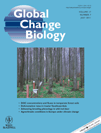Zooplankton species composition is linked to ocean transport in the Northern California Current
Abstract
In the Northern California Current (NCC), zooplankton communities show interannual and multiyear shifts in species dominance that are tracked by survival of salmon populations. These zooplankton community changes correlate with the Pacific Decadal Oscillation (PDO) index: a ‘warm-water’ copepod species group is more abundant during warm (positive) phases of the PDO and less abundant during cold (negative) phases; the reverse occurs for a ‘cold-water’ species group. The observed relationship led to the hypothesis that the relative dominance of warm/cold-water copepods in the NCC is driven by changes in the horizontal advection of surface water over different phases of the PDO. To test this hypothesis, variation in surface water advection to coastal regions of the NCC over the period of 1950–2008 was investigated using a Regional Ocean Modeling System (ROMS) and passive tracer experiments, then was compared with zooplankton collected off Oregon since 1996. Results showed that surface water advection varied with the phase of the PDO; the low-frequency component of advection anomalies strongly correlated with copepod species composition (R>0.9). During positive phases of the PDO, current anomalies were northward and onshore, resulting in transport of warmer waters and the associated copepods into the region. During negatives phases, increased equatorward current anomalies led to a copepod community that was dominated by cold-water taxa. Our results support the hypothesis that climate-driven changes in basin-scale circulation controls copepod community composition in the NCC, and demonstrate that large-scale climate forcings downscale to influence local and regional ecosystem structure.
Introduction
Changes in zooplankton species composition have been related to climate throughout the world's oceans (Peterson et al., 2002; Beaugrand & Reid, 2003; Valdes et al., 2004; Chiba et al., 2009), often in association with changes in ocean circulation (Beaugrand et al., 2002; Batten & Freeland, 2007; Mackas et al., 2007). Because zooplankton composition is fundamentally important to juvenile fish growth and survival, such changes have important implications to fisheries and marine ecosystems. In the eastern North Pacific, fluctuations in populations of many marine species have been shown to correspond to the Pacific Decadal Oscillation (PDO) (Mantua et al., 1997; Hare & Mantua, 2000; McGowan et al., 2003), but currently, the state of knowledge concerning the links between climate and populations is based on numerous correlative studies – the mechanistic links have not been well defined.
Recent studies which demonstrate intercorrelations among the PDO, zooplankton species anomalies, and survival of Endangered Species Act (ESA)-listed salmon (e.g., Peterson & Schwing, 2003; Mackas et al., 2007) led to a hypothesis that climate-driven changes in zooplankton communities impact fish populations through bottom-up processes. Furthermore, because the PDO is associated with strong alongshore transport anomalies driven by changes in atmospheric forcing (Chhak et al., 2009), alongshore displacement of boreal (cold-water) vs. subtropical (warm-water) water masses has been implicated in the climate-to-ecosystem connection.
Zooplankton communities on the continental shelf in the Northern California Current (NCC) shift between warm-water and cold-water species dominance, with strong seasonal cycles superimposed on multiyear variability. There is a strong correlation between multiyear variability in community structure and the PDO, suggesting that zooplankton vary in response to environmental changes which are controlled by basin-scale climate processes. The PDO, which is defined as the first Principal Component of North Pacific monthly sea surface temperature (SST) anomalies (Mantua et al., 1997), is driven by changes in the Aleutian Low pressure center that are physically manifest in the California Current as changes in heat fluxes and horizontal advection (Newman et al., 2003; Chhak et al., 2009). During a positive PDO, the Aleutian Low is strong, the subtropical North Pacific gyre is anomalously weak, and sea surface height (SSH) along the US west coast is anomalously high. Downwelling conditions prevail, which lead to transport of warm surface water northward and toward the coast. During cold phases of the PDO, southward transport is anomalously strong. El Niño events, which are driven by different atmospheric and oceanic forcing than the PDO, result in anomalous poleward transport of warm water along the continental shelf (Strub & James, 2002) and also have strong impacts on eastern North Pacific ecosystems (Pearcy, 2002; Peterson et al., 2002).
Here, the hypothesis that climate-related changes in horizontal advection controls zooplankton community composition in a study region off of central Oregon, USA, is tested using a Regional Ocean Model System (ROMS) and passive tracer simulations to track the advection of particles over multiple years and different phases of the PDO. Model results are compared with field observations of zooplankton community structure to show that changes in large-scale circulation in the North Pacific basin, and in the coastal study region, strongly correlate with the PDO and with indices of zooplankton community structure. This correlation indicates that horizontal transport of water masses is an important component of the link between climate fluctuations, zooplankton species distributions, and survival of culturally and economically important fish populations in the eastern North Pacific.
Methods
Transport model
Transport dynamics were investigated using the Regional Ocean Modeling System (ROMS) (Shchepetkin & McWilliams, 2005; Haidvogel et al., 2008) in a nested configuration over the eastern North Pacific region 180°–110°W; 25°–62°N (Fig. 1). The model computational grid has an average horizontal resolution of 10 km with 30 vertical terrain-following layers. This model configuration is eddy-permitting and has been used in previous studies to successfully capture the low-frequency dynamics in the California Current and Gulf of Alaska (Di Lorenzo et al., 2008, 2009; Chhak et al., 2009). At the surface, wind stresses and heat fluxes are prescribed from the US National Center for Environmental Prediction (NCEP) (Kistler et al., 2001) for the period 1950–2009. The mean seasonal cycle of heat and freshwater flux for temperature and salinity also is corrected as described in Di Lorenzo et al. (2009) to avoid long-term drifts associated with errors in the NCEP surface fluxes (Josey et al., 2001). For the SST, a time dependent nudging to the NOAA SSTs (Smith & Reynolds, 2004) is also imposed to account for air–sea interactions not resolved in the model setup.
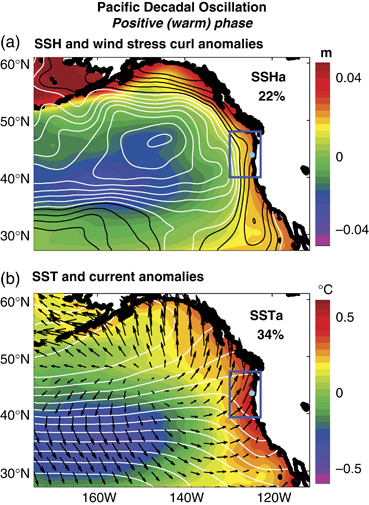
Large-scale structure of the Pacific Decadal Oscillation (PDO) in sea surface height anomaly (SSHa) and SSTa from the eastern North Pacific Model. (a) SSHa map with superimposed contours of wind stress curl anomalies during the positive PDO phase. White (black) contours indicate regions of positive (negative) Ekman pumping resulting in upwelling (downwelling) conditions. (b) Black arrows correspond to wind-driven Ekman currents based on a regression of the model PDO and NPGO index with the model ocean currents. White contours correspond to the climatological mean SST gradients with cooler SSTs in the Gulf of Alaska. The percent of variance explained by each regression map is denoted within the panels. Originally published in Chhak et al., 2009. The blue rectangle is the location of the ROMS model grid used in this study with the light blue dot denoting the location of the zooplankton collections from station NH5.
To study changes in water mass transport in the Northern California Current (NCC), a smaller size computational grid with the same spatial resolution as the eastern North Pacific ‘parent’ grid was nested to cover the Oregon shelf region from 40° to 47°N, 130°W to the coast (Fig. 1). The parent grid provided boundary conditions for the regional grid. Passive tracers were constantly released at the surface along the regional model's north, south, east, and west boundaries. To avoid the accumulation of tracers in the interior region, and to better represent the short (<1 year) life span of most zooplankton, the passive tracer equation contains a decay term with a 12-month timescale that is active when the tracer is away from the boundaries. Temporal and spatial patterns of the accumulation of tracers within the study region were examined, calling tracers that arrived from the northern, southern, western, and eastern boundaries the North, South, West, and East tracers, respectively.
The PDO, which indexes monthly changes in the spatial pattern of SST in the north Pacific, is available at http://jisao.washington.edu/pdo. To investigate physical variability that is associated with changes in the phase of the PDO, time periods which correspond to 36 extreme negative and positive events of the PDO were identified following Chhak et al. (2009). SSH, SST, and Ekman layer velocities were extracted from the model within these time periods, and ensembles of the physical properties were created over the positive and negative phases of the PDO.
Zooplankton data; the Copepod Community Index (CCI)
Zooplankton data were available from a station located 9 km (5 nautical miles) offshore of Newport, Oregon in 60 m water depth (44.65°N; 124.18°W, Station ‘NH5’) (Fig. 1) which has been sampled approximately bi-weekly to monthly since 1996. Zooplankton were collected using a 50-cm diameter, 202-μm mesh ring net, towed vertically from 5 m above the sea floor to surface, at a rate of 30 m/min. A TSK flowmeter was used to monitor the amount of water filtered. Samples were preserved in 5% neutrally buffered formalin and returned to the laboratory where zooplankton were identified by species and developmental stage and the abundances (number of individuals m−3) were calculated. For this study, the focus is on copepods, which usually comprise the majority (>80%) of the mesozooplankton biomass at our study location and consist of taxa which can be excellent indicators of different water masses.

Following analysis of the matrix, the resultant two-dimensional ordination was rigidly rotated so that the maximum possible variance in copepod community structure was carried on Axis 1. This rotation did not affect the geometry of points in the ordination space, or the total variance explained by the ordination, but simply realigned the ordination points such that the longest axis of dissimilarity in community structure among sample dates was expressed along the first axis (McCune & Grace, 2002). The Axis 1 scores then represented the positions of the sampling dates along the dominant axis of community separation, ignoring the positions along other axes, and a time series plot of the Axis 1 scores permitted an evaluation of the relative changes in community structure over time. Hereafter, these scores are termed the ‘CCI’.
Because the PDO and transport indices are available as monthly values whereas the zooplankton sampling occurred approximately bi-weekly to monthly, the CCI values were linearly interpolated to monthly values for comparison. Unless otherwise noted, all time series were 3-month low pass filtered before plotting to emphasize the low-frequency variability of interest.
Transport and zooplankton regressions
The CCI was compared with passive tracer time series to examine transport controls on copepod species composition. To do this, the alongshore and across-shelf range over which to integrate the tracers was first tested by comparing their fit to the CCI when integrated over different size regions: varying the alongshore range had less influence on the fit between the biological and model time series than varying the zonal range, indicating both greater alongshore coherence in transport processes compared with cross-shelf processes and that the zooplankton time series reflects changes in continental shelf processes that may not represent oceanic processes as well. This result is further examined below. The tracer concentrations were then integrated over the geographical region where they best fit the CCI: a 2° latitude by 1° longitude region centered around the zooplankton data collections, 43.7–45.7°N, 124–125°W, to create time series of the North, South, East, and West advection pathways. Next, a multiple regression model populated with the four tracer time series was constructed to examine the total variance in the CCI that could be explained by horizontal water movements. Finally, this regression was used to hindcast the CCI over the full model time domain to investigate potential historic variability in relation to climate patterns.
Significance test of correlations
The time series presented in this study exhibited significant autocorrelation (e.g., red noise processes) implying that the effective degrees of freedom are reduced when testing the significance. Therefore, the significance of the cross-correlations was tested using a Monte Carlo technique in which each time series was first approximated as a simple auto-regressive model of order 1 (AR-1) with the proper autoregression coefficients computed from the original time series. Then, the two AR-1 models were used to generate 5000 realizations of each time series, compute cross-correlations between them, and populate the sample probability distribution function (PDF) of the cross-correlation coefficients to assess the 95% and 99% confidence intervals. An example of such a PDF is provided in the description of Fig. 3 below. Throughout the text, correlations are reported as the R values. All analyses were conducted in MatLab 7.0.1 (The MathWorks Inc., Natick, MA, USA).
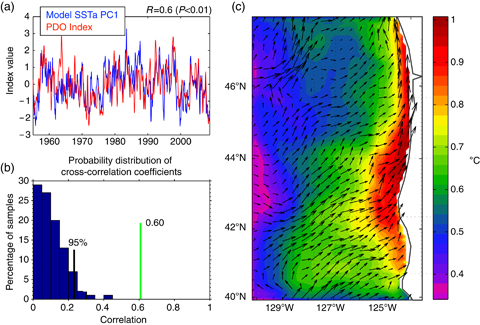
The Pacific Decadal Oscillation (PDO) mode in the regional model. (a) Comparison between the time series of the model SSTa PC1 and the PDO index. (b) Montecarlo significance test of correlation between model SSTa PC1 and PDO index. (c) EOF1 of model SSTa showing a PDO-like structure, obtained by multiplying the EOF spatial pattern by the standard deviation of the principal component temporal evolution. Black vectors correspond to the surface currents anomalies during the positive phase of the model PDO, obtained by regressing the model PDO index with the surface velocities.
Results
Transport model: the PDO and changes in horizontal transport
Examination of model sea surface height anomaly (SSHa) and Ekman velocity fields demonstrate that the ROMS successfully captures the dominant PDO patterns that have been shown in analyses of ocean observations (Mantua et al., 1997; Chhak et al., 2009). During the positive (warm) phase of the PDO, modeled SSHa exhibits positive anomalies along the full extent of the west coast of the US, and negative anomalies in the center of the North Pacific basin (Fig. 1). In our study region of the NCC (Fig. 1, blue rectangles), the high coastal SSH anomalies indicated anomalous northward geostrophic currents that were associated with wind-driven downwelling conditions. However, the anomalous surface currents during positive phases of the PDO (panel B) also had an important west-to-east component that did not follow the SSHa contours, indicating that onshore Ekman surface currents anomalies are important during the positive phase of the PDO.
Transport model: the seasonal cycle
The seasonal means of the surface passive tracers experiments in the study region (Fig. 2) captured the development of the upwelling cycle that dominates seasonal dynamics in the NCC. In summer and autumn, winds and currents are primarily equatorward and upwelling conditions dominate; the tracer advection was characterized by stronger offshore dispersion of the East passive tracers (tracers released from the eastern boundary) and a weaker intrusion of the West passive tracer. The reverse was true during winter and spring, when poleward winds and downwelling conditions dominate. The upwelling cycle also was evident in the North tracer results, which showed higher values along the coast associated with the signature of the southward coastal upwelling jet that develops in response to the upwelling-driven, zonal sea surface tilt. The South tracer had a weaker dependence on the seasonal cycle, showing little intrusion into the region in all seasons. However, during winter through spring, the signature of a northward coastal current (the Davidson Current) is evident from a higher proportion of South tracers and a lower proportion of North tracers penetrating along the coastal boundary. These results demonstrate that the model East/West tracers capture the coastal upwelling dynamics and that transport from the north is an important component of the seasonal cycle in the NCC.
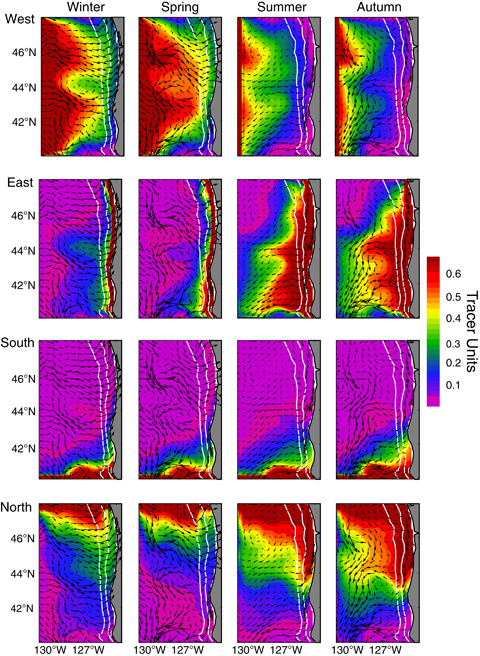
Seasonal means of the accumulation of surface passive tracers released from the four boundaries, West, East, South, and North, averaged over the entire model time period. Winter, D, J, F. Spring, M, A, M; Summer, J, J, A; Autumn, S, O, N. Color indicates the resultant concentration of tracers that were advected into the grid location from the release boundary. Black vectors show the direction of the mean seasonal currents; white contours define the seaward edge of the continental shelf and slope.
Transport model: the PDO and low-frequency changes in transport
The NCC regional ocean model was verified as adequately reproducing the PDO mode in SST anomalies by reconstructing the PDO using the EOF1 of the model SSTa and comparing it with the ‘true’ PDO. The reconstruction shows the typical spatial pattern of the PDO that has previously been described from observations (Mantua et al., 1997), with anomalously warm coastal waters relative to offshore waters during the positive phase, and the opposite pattern during the negative phase (Fig. 3c; negative phase not shown). The monthly anomalies of the PC1 of the model SSTa tracked the PDO index (R=0.60, P<0.01) (Fig. 3a and b). Surface current anomalies during the positive phase of the PDO (Fig. 3c) showed downwelling (west to east) currents, and strong poleward currents at the coast in the northern region.
Maps of the passive tracer transport results composited over the 36 most strongly positive and negative phases of the PDO show large differences in the direction of horizontal advection (Fig. 4). During the positive (warm) phase, there was less advection from the north, more from the west, and less from the east (the coastal upwelling region) compared with the negative (cold) phase. The South tracer shows poleward advection on the continental shelf very close to the coast during the positive phase of the PDO that is not strongly mirrored in the North tracer during the negative phase.
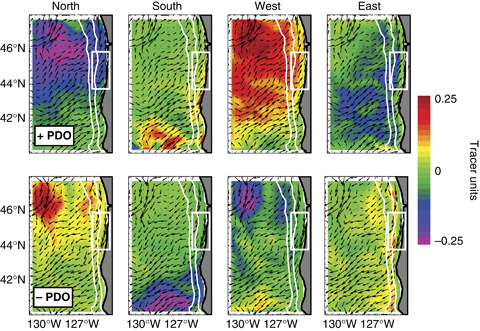
Spatial distribution of passive tracers composited over the 36 most extreme positive (top row) and negative (bottom row) phases of Pacific Decadal Oscillation (PDO). Anomalies are shown for each tracer release from the North, South, West and East boundaries. Black vectors are the surface current anomalies during the positive (negative) phase of the model PDO, obtained by regressing the model PDO index (PC1 of SSTa) with the surface velocities. White boxes define the ‘local’ study area where zooplankton data exist. White lines define the seaward edges of the continental shelf and slope.
Overall, the strongest transport anomalies over the full regional model domain occurred in the North and West tracers, indicating that the dominant PDO signal in horizontal surface advection is increased intrusion of waters from the west (consistent with downwelling conditions) and decreased transport of waters from the north, both of which result in transport of warmer waters into the region. The intrusion of southern waters is confined along the coast and is not a major contributor to the overall water mass budget during positive PDO, although its contribution at the coast is locally very important. The opposite occurs during the negative phase of the PDO, although again, the positive and negative phase anomalies are not symmetric.
Construction of the CCI
The NMDS ordination of the ‘copepod species abundance’בtime’ matrix resulted in a two-dimensional ordination with a final stress of 19.7. After rotation, the majority (71%) of the variance in copepod community structure among sample dates lay along Axis 1 (the ‘CCI’), with Axis 2 explaining only 13% of the variance. CCI values ranged from −1.6 to 2.0, with negative values indicating dominance of cold-water taxa and positive values indicting a shift towards dominance of warm-water taxa, as described in more detail below.
Temporal patterns in the CCI
The most apparent signal in the CCI was the strong seasonal cycle (Fig. 5a) that has been previously described for this location (Peterson & Miller, 1977; Peterson & Keister, 2003). Neritic (coastal) taxa with cold-water affiliations dominated the zooplankton at most times. The importance of warm-water taxa increased each winter, but, during our study period (1996–2008), only dominated the biomass for short periods during warm phases of the PDO and during extreme warm climate anomalies such as the 1997/1998 El Niño. The dominant cold-water copepods were neritic taxa (Table 1). Warm and cold-water oceanic taxa played a lesser role in controlling community composition.

(a) Time series of the Copepod Community Index (CCI) generated from NMDS Axis-1 ordination scores. (b) As in (a), but with seasonal cycle removed. Vertical dashed lines define approximate periods of shifts in copepod community type, as determined from the ordination scores. (c) Correlation between the model PDO index and monthly-interpolated anomalies of the CCI (no smoothing applied).
| Species* | R | R 2 | Water-mass affiliation |
|---|---|---|---|
| Acartia longiremis (Lilleborg, 1853) | −0.66 | 0.43 | Cold-water neritic |
| Calanus marshallae (Frost, 1974) | −0.64 | 0.41 | Cold-water neritic |
| Centropages abdominalis (Sato, 1913) | −0.55 | 0.30 | Cold-water neritic |
| Pseudocalanus spp. (Boeck, 1872) | −0.56 | 0.31 | Cold-water neritic |
| Ctenocalanus vanus (Giesbrecht, 1888) | 0.85 | 0.72 | Warm neritic |
| Paracalanus parvus (Claus, 1863) | 0.60 | 0.36 | Warm neritic |
| Calanus pacificus (Esterly, 1924) | 0.59 | 0.35 | Warm oceanic** |
| Calocalanus styliremis (Giesbrecht, 1888) | 0.73 | 0.53 | Warm oceanic |
| Clausocalanus arcuicornis (Dana, 1849) | 0.72 | 0.52 | Warm oceanic |
| Clausocalanus pergens (Fleminger, 1964) | 0.76 | 0.58 | Warm oceanic |
| Corycaeus anglicus (Lubbock, 1857) | 0.65 | 0.43 | Warm oceanic |
- * Taxonomic authorities taken from Gardner & Szabo (1982).
- ** ** A cold-water form that inhabits the Gulf of Alaska was not separately identified and may have been present in low numbers.
The largest interannual signal occurred in summer 1998 following the strong 1997/1998 El Niño; 1998 was the only summer in which the CCI did not reach negative values indicating that warm-water taxa were anomalously abundant throughout the year. Peterson & Keister (2003), who previously described the impact of the 1997/1998 El Niño on zooplankton composition at this study location, found anomalies in warm-water taxa from late 1997 through late 1998, several months after the physical signal of the El Niño had abated. Large positive anomalies in warm-water taxa (indicated by positive CCI values; Fig. 5b) also occurred during summer 2005 when upwelling in the CCS was suppressed for several weeks beyond the normal spring transition (Kosro et al., 2006; Pierce et al., 2006), resulting in warm surface layers and extremely low production (Thomas & Brickley, 2006).
Nonseasonal anomalies in the CCI time series (Fig. 5b) revealed low-frequency shifts between periods of relative dominance of warm-water taxa (1996–1999 and 2003–2006) and cold-water taxa (1999–2003 and 2006–2008) that corresponded to periods of warm/cold anomalies in the PDO (Fig. 5c). The time series of the PDO and anomalies of the CCI were significantly correlated (R=0.54, P<0.01 with no smoothing) implying a link between the climate index and changes in zooplankton communities. Not surprisingly, the regional model PDO index, inferred as the first principal component of model SSTa, correlated more strongly with the CCI (R=0.66, P<0.001 with no smoothing) (Fig. 5c) indicating the importance of regional dynamics to the biology.
Passive tracer time series
Time series of tracer concentrations, used to test the mechanistic link between climate variability, circulation, and zooplankton community structure, revealed large interannual and low-frequency variability in advection of surface-water into our study region (Fig. 6). Time series of the tracers averaged over the coastal study region (white boxes in Fig. 4) all showed significant correlations with the model PDO over the full model period of 1950–2009, but each captured different aspects of PDO-related variability. For example, the 1976 climate ‘regime’ shift from a cold to warm phase of the PDO is evident in the South and East tracer time series, less so in the North, and was absent in the West tracer. The 1997–1998 El Niño is evident in all of the tracer time series, but was best captured by the North, West, and East tracers.
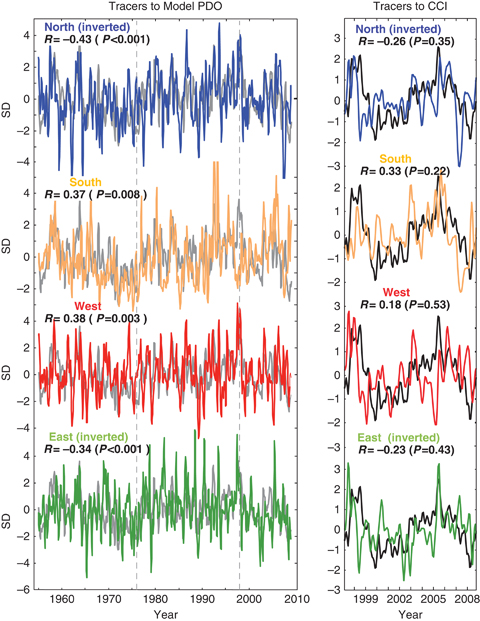
Time series of passive tracers averaged in the coastal region (43.7N–45.7N, 125W–124W) shown as white boxes in Fig. 4. Tracers released from the North (blue), South (orange), West (red), and East (green) correlated with (left panels) the model Pacific Decadal Oscillation (PDO) (gray lines) and (right panels) the CCI (black line). North and East tracers time series are inverted so that warm-water advection into the study area is indicated by positive anomalies in all time series. Vertical dashed lines are at January 1976 and 1998.
The tracer time series also each captured different aspects of the CCI with no one tracer describing the CCI well overall (Fig. 6, right panels). Overall, the South tracer best fit the CCI time series, but the correlation was not strong. The North tracer best fit the time period of 1999–2003 as the CCI steadily increased. The East tracer best fit the strong 2005 anomaly and subsequent years of decreasing CCI values, indicating anomalously low transport from the east that is consistent with decreased upwelling. The early 2005 time period also showed decreased transport from the north and an increase from the south. As with the PDO correlations, the North, West, and East tracers best captured the positive anomalies in the CCI during the 1997–1998 El Niño, whereas very little signal was captured by the South tracer.
Because the advection that controlled tracer movements reflected the same physical forcings to different degrees, the passive tracer time series were not independent of each other. Over the entire time series, the North tracer negatively correlated with the South (R=−0.44, P<0.001) and West (R=−0.73, P<0.001) tracers. The East tracer was negatively correlated with the West (R=−0.45, P<0.001) and South (R=0.18, P=0.03) tracers. During the positive phase of the PDO, the region experiences less intrusion of North and West tracers, and more intrusion of South tracer, as shown in Fig. 4. The downwelling conditions associated with the PDO also triggered a net transport of waters from west to east that explains the negative correlations between the East and West tracers. Correlations among other tracer pairs were low and not significant.
Passive tracer linear model reconstruction of the CCI
A passive tracer linear model reconstruction of the CCI captured the dominant low-frequency variability in species composition over the time of the field sampling (Fig. 7a and b). Using all four boundary tracers, the correlations between the model reconstruction and the observed CCI ranged from R=0.36 (P=0.05) for the raw time series, to R=0.96 (P<0.001) for 5-year low-pass data. Low-pass filtering a model reconstruction of the CCI over the full time period revealed regular 6–7 year cycles that correspond to similar cycling in the PDO (Fig. 7c and d). The model CCI trended from positive anomalies (greater warm-water species dominance) in the late 1950s to a minimum (cold-water species dominance) in 1974 before increasing in the 1980s to fluctuate about the mean with generally positive anomalies. The observational time series (1996–2009) occurred during a period of generally positive anomalies.
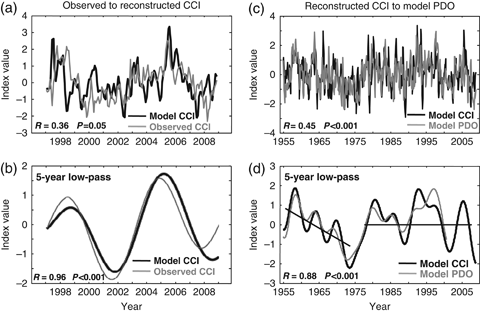
Model reconstruction of the Copepod Community Index (CCI). Comparison of model CCI (a and b) with observed CCI over the time period of the field observations, and (c and d) with model PDO. The hindcast model was constructed by fitting the N, S, E, and W passive tracer time series to the raw CCI data: CCI=−0.08*N+0.21S±0.21E+0.04W+ɛ. Straight lines in (d) represent the visually estimated trends over the periods before and after the 1976 PDO regime shift.
The South and East tracers contributed the highest portion of the variability in the reconstruction. The West tracer did not make an important contribution to the reconstruction largely because it shares a large component of its variability with the East tracer. Because some pairs of tracers were cross-correlated as described above, redundant variables were tested for in the reconstruction model by fitting the model using pairs of tracers. The best fit when reducing the model to two tracers resulted from the combination of the South and East tracers (Rmax=0.89 with 5 year low-pass, P=0.01) confirming that those two tracers explained different components of the variability in the zooplankton time series. The West and North tracers did not significantly improve the model fit over the full CCI time period compared with the two tracer model, but best captured anomalies in the CCI during the 1997/1998 El Niño (Fig. 6) and tightened the lag of the model behind the observations when the CCI increased rapidly from negative to positive anomalies in early 2003 (Fig. 7a), so were retained for the hindcast model.
The full-period reconstruction of the CCI strongly correlated with the model PDO (R=0.45, P<0.001 for the raw data; R=0.88, P<0.001 for the 5-year low-pass data) (Fig. 7c and d). To better understand how each tracer relates to the low-frequency variability indexed by the PDO, the coherence between the model PDO and the individual tracer time series used in the linear model was analyzed (Fig. 8). This coherence analysis used the Fourier transform to decompose the original signals into components associated with different periodicities, then computed the correlations of the two signals at each periodicity (Fig. 8a and b). From this, the periodicities that contributed most to the correlation between the raw, unfiltered signals were determined. At the coastal continental shelf location, the high frequency variability (timescales up to 2 years) was dominated by transport from the north and west. Towards the lower frequencies, the South tracer explained more variance (Fig. 8a) but its influence was mainly confined to the coastal shelf region, as is evident from spatial correlation maps of the model PDO with the tracer anomalies (Fig. 8c).
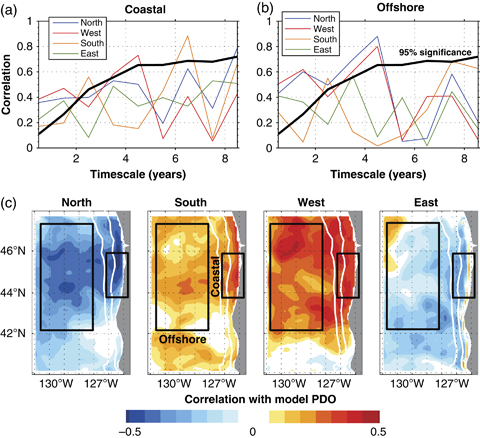
Spatial and temporal structure of model Pacific Decadal Oscillation (PDO) correlation with tracers. Correlations of (a) coastal and (b) offshore average tracers with the model PDO index as a function of different timescales of variability. Black line marks the 95% significance level for the correlation. (c) Spatial correlation maps between model PDO and passive tracers. White contours define the seaward edge of the continental shelf and slope. The black rectangles in lower panels define the coastal shelf region, where zooplankton data is available, and an offshore domain beyond the continental slope.
In the offshore region (42.5–47.5°N; 129.5–126.5°W) off the continental shelf, the PDO signal in the advection was dominated by the North and West tracers over most time scales (Fig. 8b). However, in the spatial domain, some effect of advection from the south was evident off Heceta Bank (44.0–44.6°N) where coastal currents turn offshore. In conclusion, during the different phases of the PDO, variability in coastal shelf waters was strongly dominated by advection from the north, west, and south, whereas offshore of the continental slope, the dominant PDO signal is characterized by intrusion of northern and western waters.
Discussion
Zooplankton communities on the continental shelf in the NCC vary between warm-water and cold-water species dominance, with strong seasonal and 6–7 year cycles superimposed on multidecadal variability. A strong correlation between multiyear variability in community structure and the PDO was found, suggesting that zooplankton vary in response to environmental changes which are controlled by basin-scale climate processes. Because observational data show that local and large-scale alongshore transport anomalies vary with the phase of climate indices such as the PDO and Northern Oscillation Index (NOIx), previous studies of zooplankton anomalies in the NCC have hypothesized that transport controls climate-correlated shifts in species composition (e.g., Mackas et al., 2001; Hooff & Peterson, 2006), but a mechanistic test of the hypothesis has been lacking. The model experiments conducted here establish that direct mechanistic link: PDO-related changes in horizontal surface advection explained the vast majority of the multiyear variability in zooplankton communities.
Long-term change studies throughout the North Pacific have reported correlations among biological time series and climate variability that is indexed by the PDO, Multivariate El Niño Southern Oscillation Index (MEI) and other climate indices. Variability in several important pelagic and benthic fish populations have been related to the PDO (many reviewed in Mantua & Hare, 2002). With respect to zooplankton, Chiba et al. (2009) reported geographical shifts in copepod communities in the Kuroshio/Oyashio region that corresponded to southward displacement of the Oyashio following a PDO regime shift. In the southern California Current CalCOFI region, Brinton & Townsend (2003) found a strong relationship between the PDO and abundances of some euphausiid taxa. Mackas et al. (2001) reported that atmospheric pressure anomalies which are indexed by the NOIx control anomalies in warm-water zooplankton that are found off Vancouver, BC. Together, these findings show the strong influence of basin-scale climate forcing on regional physical and biological processes. Furthermore, much of the biological variance around the North Pacific basin has been related to the PDO, suggesting that coherent patterns of variability around the basin may emerge through integrated studies.
A complex relationship between the circulation, which represents source waters, and species composition at this continental shelf location was revealed in these results. Advective pathways differed over time and by region, particularly between the deep basin and the continental shelf. Correlations between the advection and the zooplankton show that advection from the north and south are most strongly associated with changes in zooplankton composition on the continental shelf, but that advection from the west can be important at times when alongshore advection does not explain community changes. It is well known that geostrophic flow tends to follow bathymetric contours, not cross them, thus the steep topography of the continental slope restricts geostrophic cross-slope exchange. As a result, alongshore velocities are higher than cross-shelf velocities (Huyer, 1983), and gradients in both alongshore physical properties and zooplankton communities tend to be smoother than cross-shelf gradients (Mackas, 1984). In addition, many zooplankton exhibit ontogenetic and diel vertical migration behaviors that increase retention of populations on the continental shelf in 2-layer, wind-driven upwelling regions (Peterson, 1998). Together, these geophysical and biological processes likely contributed to the finding that open-ocean processes are not tightly tied to variability in continental shelf zooplankton communities.
It is particularly interesting that eastward transport fit the CCI better than transport from the south during the El Niño since poleward transport during El Niño events is known to advect coastal taxa hundreds of km along the coast in the CCS (Tanasichuk & Cooper, 2002; Keister et al., 2005). The exceptionally strong downwelling signal indicated by transport from the west provides evidence that transport of warm ocean water toward shore may be relatively more important during El Niño events than at other times.
It is also noteworthy that the study region is not homogenous with respect to transport anomalies in the alongshore direction. At approximately the latitude of Cape Blanco (42.8°N), a strong break in the tracer anomalies indicates that different hydrographic regimes occur to the north and south (Fig. 4). Most striking are differences in the intrusion of tracers from the north during both PDO phases, and from the south and west during the positive PDO. Cape Blanco has been hypothesized to be a barrier to alongshore transport of fauna (Peterson & Keister, 2002) and is frequently the northernmost location at which the summer upwelling jet deviates offshore of the shelf, resulting in meanders of the jet, strong zonal transport, and the development of upwelling filaments (Barth et al., 2005). South of Cape Blanco, the circulation is much more complex, and zonal flow and mesoscale variability is high (Keister & Strub, 2008). Those regional differences in circulation may result in different responses to climate forcing, and may complicate the extrapolation of results presented here to the entire NCC.
The reconstruction of the copepod community over the full model time period (Fig. 7c) must be viewed with caution as the factors that shaped the observed community over the past 14 years may not have played the same roles in the past. But the pattern that emerged in the low-frequency variability is intriguing, even if it is only indicative of changes in circulation. The transport patterns over 1950–2009 showed strong coherence with the PDO, capturing both the long-term patterns and the regular (perhaps El Niño-related; Newman et al., 2003) 6–7 year cycles. The 1976 ‘regime shift’ in the PDO that has been correlated with many biological time series (Mantua et al., 1997; Hare & Mantua, 2000) is seen in the CCI hindcast as a transition from steadily decreasing values to higher, generally positive values. If these values can be extrapolated to historic zooplankton communities, they would indicate a shift from increasing dominance of cold-water species to a more steady dominance by warm-water taxa in recent years.
Climate-related changes in zooplankton that cannot explicitly be addressed here are those due to global temperature increases over the last century. Long-term temperature increases are likely to have impacted zooplankton in the NCC before the observational time period, including potential northward movement of species ranges, increased growth rates, and increased dominance of warm-water taxa. Those changes may not have been indexed by variations in transport, and would not have been captured by dynamics indexed by the PDO which does not contain a trend component.
Although the dominant changes in transport associated with low-frequency climate fluctuations in this coastal study region are in the north–south direction, the processes that control zooplankton distributions in the NCC are more complex than simple ‘upwelling/downwelling’ or ‘poleward/equatorward’ transport indices can describe. Thus, developing circulation indices of changes in ecosystem properties should be undertaken with care: such indices may work well to explain low-frequency variability, but lose explanatory power on short time scales that are relevant to the biology. Biological indices such as the CCI that integrate both short and long-term physical signals in an ecologically meaningful way may be essential for tracking changes relevant to ecosystem dynamics and resource management.
Conclusions
Global climate change is likely to impact ocean circulation on local through basin scales. Predicting the impact of those changes will be challenging given the complexity of circulation patterns and their interaction with other environmental changes (e.g., temperature, mixed layer depths) that can also have large impacts on zooplankton production. Temporal and geographical shifts in zooplankton communities have important implications to fish and other higher trophic level predators. High-latitude, cold-water zooplankton tend to have large body sizes and to accumulate lipid stores which allow them to survive the winter months. In contrast, warm-water taxa tend to be smaller and less lipid-rich (Lee et al., 2006). Consequently, circulation-driven shifts in communities can directly translate to differences in fish growth and survival. Studies linking fish populations to zooplankton taxonomic composition support the hypothesis that prey quality and composition are fundamentally important to fish survival. In the eastern North Pacific, field and modeling studies have shown strong intercorrelations among zooplankton lipid content and salmon survival indicating that zooplankton species composition can be as or more important to predators than prey quantity (Trudel et al., 2002). Such studies may ultimately provide the links between climate variability, ocean transport, zooplankton species composition, and salmon survival in the California Current System.
Acknowledgements
We thank N. Mariani and G. Kowalke for assistance with data analysis. Numerous scientists and ship crew participated in the zooplankton collections over the years; we particularly thank T. Shaw, L. Feinberg, J. Menkel, J. Peterson, and J. Lamb. Without all of them, this project would not have been possible. Funded was provided by the National Science Foundation under grant #OCE-0814698. This is U.S. GLOBEC contribution #682.



